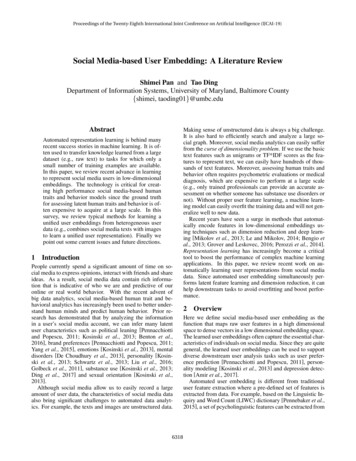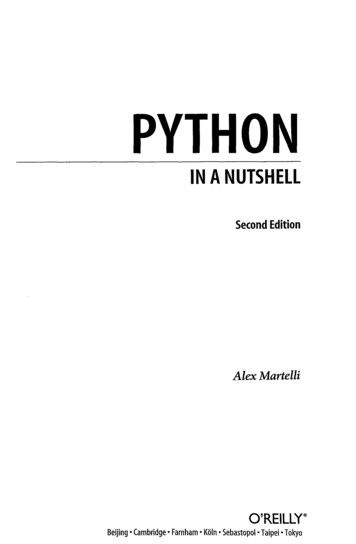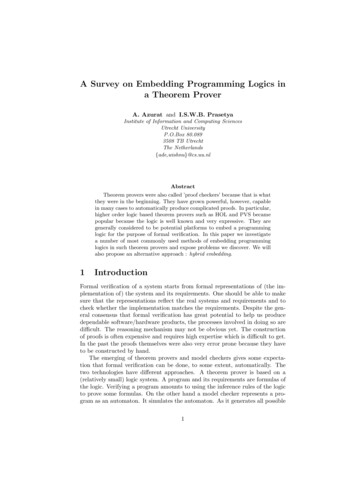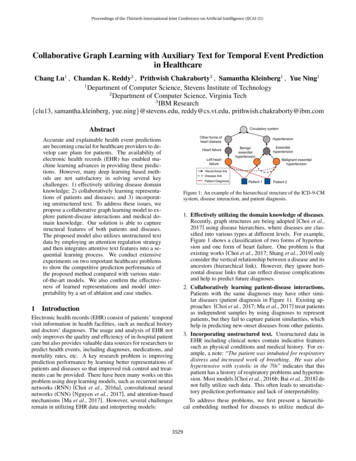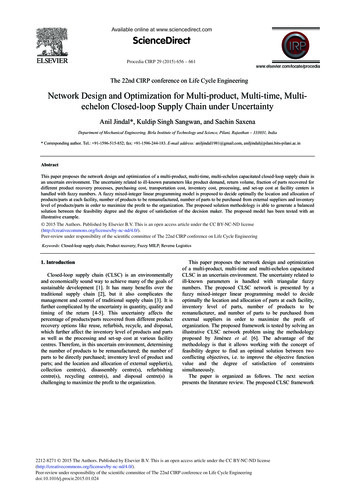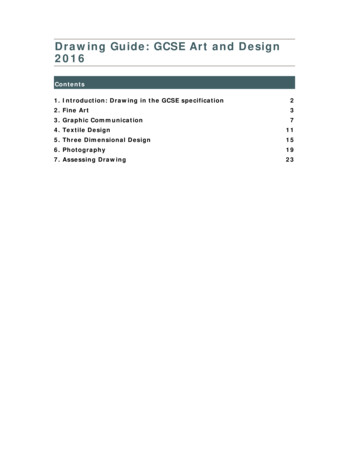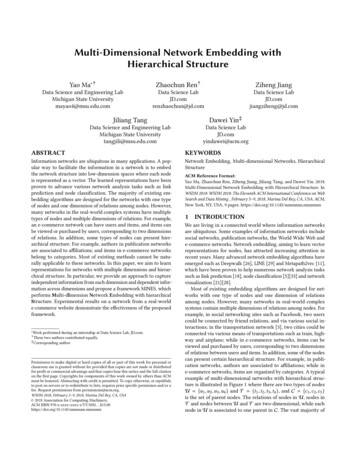
Transcription
Multi-Dimensional Network Embedding withHierarchical StructureYao Ma †Zhaochun Ren†Ziheng JiangData Science and Engineering LabMichigan State Universitymayao4@msu.edu.comData Science LabJD.comrenzhaochun@jd.comData Science LabJD.comjiangziheng@jd.comJiliang TangDawei Yin‡Data Science and Engineering LabMichigan State Universitytangjili@msu.edu.comData Science on networks are ubiquitous in many applications. A popular way to facilitate the information in a network is to embedthe network structure into low-dimension spaces where each nodeis represented as a vector. The learned representations have beenproven to advance various network analysis tasks such as linkprediction and node classification. The majority of existing embedding algorithms are designed for the networks with one typeof nodes and one dimension of relations among nodes. However,many networks in the real-world complex systems have multipletypes of nodes and multiple dimensions of relations. For example,an e-commerce network can have users and items, and items canbe viewed or purchased by users, corresponding to two dimensionsof relations. In addition, some types of nodes can present hierarchical structure. For example, authors in publication networksare associated to affiliations; and items in e-commerce networksbelong to categories. Most of existing methods cannot be naturally applicable to these networks. In this paper, we aim to learnrepresentations for networks with multiple dimensions and hierarchical structure. In particular, we provide an approach to captureindependent information from each dimension and dependent information across dimensions and propose a framework MINES, whichperforms Multi-dImension Network Embedding with hierarchicalStructure. Experimental results on a network from a real-worlde-commerce website demonstrate the effectiveness of the proposedframework.Network Embedding, Multi-dimensional Networks, HierarchicalStructure Workperformed during an internship at Data Science Lab, JD.com.two authors contributed equally.‡ Corresponding author† ThesePermission to make digital or hard copies of all or part of this work for personal orclassroom use is granted without fee provided that copies are not made or distributedfor profit or commercial advantage and that copies bear this notice and the full citationon the first page. Copyrights for components of this work owned by others than ACMmust be honored. Abstracting with credit is permitted. To copy otherwise, or republish,to post on servers or to redistribute to lists, requires prior specific permission and/or afee. Request permissions from permissions@acm.org.WSDM 2018, February 5–9, 2018, Marina Del Rey, CA, USA 2018 Association for Computing Machinery.ACM ISBN 978-x-xxxx-xxxx-x/YY/MM. . . 15.00https://doi.org/10.1145/nnnnnnn.nnnnnnnACM Reference Format:Yao Ma, Zhaochun Ren, Ziheng Jiang, Jiliang Tang, and Dawei Yin. 2018.Multi-Dimensional Network Embedding with Hierarchical Structure. InWSDM 2018: WSDM 2018: The Eleventh ACM International Conference on WebSearch and Data Mining , February 5–9, 2018, Marina Del Rey, CA, USA. ACM,New York, NY, USA, 9 pages. ONWe are living in a connected world where information networksare ubiquitous. Some examples of information networks includesocial networks, publication networks, the World Wide Web ande-commerce networks. Network embedding, aiming to learn vectorrepresentations for nodes, has attracted increasing attention inrecent years. Many advanced network embedding algorithms haveemerged such as Deepwalk [26], LINE [29] and Metapath2vec [11],which have been proven to help numerous network analysis taskssuch as link prediction [18], node classification [5][33] and networkvisualization [21][28].Most of existing embedding algorithms are designed for networks with one type of nodes and one dimension of relationsamong nodes. However, many networks in real-world complexsystems contain multiple dimensions of relations among nodes. Forexample, in social networking sites such as Facebook, two userscould be connected by friend relations, and via various social interactions; in the transportation network [3], two cities could beconnected via various means of transportations such as train, highway and airplane; while in e-commerce networks, items can beviewed and purchased by users, corresponding to two dimensionsof relations between users and items. In addition, some of the nodescan present certain hierarchical structure. For example, in publication networks, authors are associated to affiliations; while ine-commerce networks, items are organized by categories. A typicalexample of multi-dimensional networks with hierarchical structure is illustrated in Figure 1 where there are two types of nodesU {u 1 , u 2 , u 3 , u 4 } and T {t 1 , t 2 , t 3 , t 4 }, and C {c 1 , c 2 , c 3 }is the set of parent nodes. The relations of nodes in U, nodes inT and nodes between U and T are two-dimensional; while eachnode in U is associated to one parent in C. The vast majority of
t1t3t2t4Dimension 2u1u2u3t1u4t2t3u3u4t4Dimension 1u1u2c1c2c3Figure 1: An illustrative example of a multi-dimensional network with hierarchical structureexisting embedding algorithms cannot be naturally applicable tomulti-dimensional networks with hierarchical structure as shownin Figure 1.In this paper, we aim to learn representations of nodes in networks with multiple dimensions and hierarchical structure. In particular, we study approaches (1) to mathematically capture multidimensional information and hierarchical structure; and (2) to incorporate such information simultaneously for embedding. Consequently, we propose a framework MINES for Multi-dImensionalNetwork Embedding with hierarchical Structure. Our major contributions are summarized as follows: Providing a principled approach to model multi-dimensionalnetworks, which can capture independent information fromeach dimension and dependent information across dimensions; Proposing a framework MINES, which incorporates multidimensional relations and hierarchical structure into a coherent model for node representation learning; and Validating the effectiveness of the proposed framework in areal-world e-commerce network.The rest of this paper is arranged as follows. In Section 2, wereview some works that are related to our problem. The problemof embedding networks with multiple dimensions and hierarchical structure to vector space is formally defined in Section 3. Theapproach to model networks with multiple dimensions and hierarchical structure and the proposed framework with an optimizationmethod are introduced in Section 4. The experiments on a realworld e-commerce network with discussions are presented in Section 5. The conclusion and future work are presented in Section 6.2RELATED WORKOur work is related to multi-dimensional network analysis andnetwork embedding. In this section, we briefly review them.2.1Multi-dimensional Network AnalysisNetwork analysis has been extensively studied for many years[34][35][6][14][2][7]. Multidimensional networks, which are quiteubiquitous in the real-world applications, have attracted increasingattention. In [3], the authors introduced a few examples of realworld multidimensional networks, and they also defined measuressuch as degree, neighbors for the multidimensional networks. Moremeasures for the multidimensional networks are introduced in [22].The classic link prediction problem has been extended to multidimensional networks with the new problem “what is the probabilitythat a new link between two nodes will form in a specific dimension?” [27]. Multidimensional versions of the Common Neighborsand Adamic-Adar have been introduced to solve this problem [27].In [4], the authors studied the community discovery problem in themultidimensional network setting. In [16], the authors investigatedfriendship maintenance and prediction in multidimensional socialnetworks.2.2Network EmbeddingNetworks can be represented by adjacency matrices; however, theserepresentations are too sparse and high-dimensional. Many classicmethods such as Laplacian eigenmap [1] and IsoMap [30] havebeen proposed to learn low-dimensional representations. Thesemethods work fine on small size networks but cannot be scaledto very large networks. Inspired by word2vec [23][25], DeepWalkand LINE are proposed recently which can be applied to very largescale networks. DeepWalk regards the nodes in the network as the“words” of an artificial language and uses random walk to generatethe “sentences” for this language. Then, following the procedure ofword2vec, the representations for the nodes can be learned. LINEtries to capture both the first order and second order proximity inthe representations. node2vec [13] extends DeepWalk by addingparameters to introduce the biased random walk. These networkembedding methods have shown effectiveness in various taskson many homogeneous networks. In [11], the authors extendedDeepWalk method to heterogeneous networks by introducing metapath based random walks. In [9], the authors also facilitate themeta-path to learn the heterogeneous network embedding, whilethey focus on the selection of the meta-path. In [8], the authorsfacilitate deep architectures to perform heterogeneous networkembedding. In [32], a signed network embedding algorithm SiNE isproposed based on the notion that a user should be closer to their“friend” than their “enemy”. In [20], the authors try to preserve bothlocal and global information in the network for network embedding.There are also works on attributed network embedding [17][31].Two recent surveys [10][12] give a comprehensive overview ofnetwork embedding algorithms. However, most of the existingmethods cannot naturally be applicable to networks with multipledimensions of relations and hierarchical structure. In this paper,we aim to model the multi-dimensional relations and hierarchicalstructure and propose a framework to embed these networks tovector space.3PROBLEM STATEMENTIn the multi-dimensional networks, we have different types of nodesand multiple dimensions of relations. Assume that there are K types
(i)(i)(i)of nodes in total and let Vi {v 1 , v 2 , . . . , v N } be the set of theii-th type with Ni nodes. Let V denote the set of all the nodesKÐV Vi . Some types of nodes in the network might presenti 1hierarchical structure. In other words, these nodes are associatedwith categories. For simplicity, we assume all the types of nodeshave hierarchical structures with a depth of 2, and we name theparent nodes as categories in this case. Note that though in thiswork, we focus on the hierarchical structures with a depth of 2,it is straightforward to apply the proposed framework for deeper(i) (i)(i)hierarchical structures. We set Ci {c 1 , c 2 , . . . , c M } as the setiof Mi categories for the i-th type of nodes, and set T(i) RNi Mias the matrix that describes the category information, for the i-thtype of nodes.Two nodes could be connected via multiple relations, and weregard each type of relations as a dimension. Thus, nodes from thesame type or different types can be connected in the same dimension. These connections can be described by adjacency matrices(for the same type nodes) and the interaction matrices (for different(i)types of nodes). Let Ad RNi Ni be the adjacency matrix of the i(i,j)th node type and Hd RNi Nj be the interaction matrix betweenthe i-th and j-th types of node in the d-th dimension. We targetto learn representations for each node in each dimension of the(i)(i)(i)network. Let Ud (i) {ud 1 , ud 2 , . . . , ud N } denote the represenitations of i-th type of nodes in the dimension d (d 1, . . . D) whereD is the number of dimensions.With the aforementioned notations and definitions, our problemcan be formally defined as follow:Given(i)(i)(i) K different sets of nodes, i.e., Vi {v 1 , v 2 , . . . , v N } (i i1, . . . , K);(i) multi-dimensional relations among the nodes, i.e., Ad (i (i, j)1, . . . , K) and Hd (i, j 1, . . . , K; i , j; d 1, . . . , D); the hierarchical structure information, i.e., Ti (i 1, . . . , K).We aim to learn a set of representations for all nodes, i.e.,and completely ignores information across dimensions. Hence thelearned representations for different dimensions are not related.However, dimensions are inherently related since they share thesame set of nodes. Thus, in this subsection, we study how to modelmulti-dimensional relations.Intuitively, each dimension should have its independent information individually; while all dimensions should share dependentinformation across dimensions. Therefore, the learned representations for each dimension should not only preserve independentinformation from the dimension but also keep dependent information across dimensions. To achieve this goal, for a given dimensiond, the representation ud for a node contains two components – (1)one component u for the information shared across dimensions;and (2) one component ed specific to the dimension d. With thesetwo components, we can rewrite ud as:ud f (u, ed ),(1)where f is a function to combine the shared component u and thespecific component ed . The shared component u not only capturesdependent information across dimensions but also helps the learnedrepresentations of all dimensions to be related. The specific component ed preserves independent information from the dimensiond.4.2Capturing Hierarchical StructureFor these nodes which have the hierarchical structure, we also needto model its category information (or parents). The category information is actually shared by all the dimensions, hence it should beindicated in the shared component of representations. For the nodesin the same category, they should also share the similar characteristics. Therefore, to model the hierarchical structure, the sharedcomponent of the node representation should further contain twocomponents – (1) one component cu indicates category information which is shared by all the nodes in the category, and (2) onecomponent su is specific to the node. With the defined components,we can further rewrite u in Eq. (1) as:u д(cu , su )(2)in each dimension d (d 1, . . . D).where д is the function to combine the category shared informationcu and the node specific information su . Note that Eq. (2) can beeasily extended to deeper hierarchical structure by further decomposing the category shared information cu .44.3Ud(i) (i)(i)(i){ud 1 , ud 2 , . . . , ud N }i(i 1, . . . , K)THE MULTI-DIMENSIONAL EMBEDDINGFRAMEWORK WITH HIERARCHICALSTRUCTUREIn this section, we will first introduce how to model multi-dimensionalrelations and hierarchical structure; and then discuss the proposedframework with an optimization method.4.1Capturing Multi-Dimensional RelationsIn a multi-dimensional network, all dimensions share the sameset of nodes, while having their own network structures in eachdimension. A straightforward way to learn representations for eachdimension is to perform the network embedding for each dimension, separately. This strategy treats each dimension independentlyThe Proposed FrameworkWith approaches to capture multi-dimensional relations and hierarchical structure, in this subsection, we introduce the embeddingframework MINES.To learn the embeddings for the nodes in each dimension, wefollow the idea of skip-gram model [24], which is an effective andefficient way to learn distributed representations of words. Theskip-gram model predicts surrounding context given a center word,which can be formulated as follows:p(N (wc ) wc ),(3)where N (wc ) is the set of words that surround word wc .Similarly, we can use the skip-gram to model the network in agiven dimension d. For a node v, we define all nodes connected to
(i)v as the “context” of v, which is formally defined as:Nd (v) KØi 1method, we replace each log pd (v j v) with(i)Nd (v);(4)Od (v, v j ) log σ (uTd ud j ) (i)(i)(i)where Nd is the set of i-th type of nodes that are connected tonode v in the dimension d. Note that the “context” of v consists ofdifferent types of nodes, and we treat them differently, which willbe further explained later.Then, given a center node v, we need to predict its “context” as:pd (Nd (v) v) (i)where p(v j v)KÖ(i)p(Nd (v) v) i 1KÖ(i)Öi 1 v (i ) N (i ) (v)jpd (v j v); (5)dcan be modeled using a softmax function as:exp(uTd ud j ).Íexp(uTd ud (i) )(i)(i)pd (v j v) (6)v (i ) ViIn (6), the softmax function is over the i-th type nodes Vi insteadof the whole nodes set V.To learn the representations for the dimension d, we model thisproblem as a maximum likelihood problem. In other words, weneed to maximize the probability that Nd (v) is the “context” ofnode v for all the nodes v V. Hence, we need to maximize:ÖPd pd (Nd (v) v).(7)v VWith all D dimensions, we need to jointly maximize the followingterm:P DÖPd .(8)d 1Instead of maximizing Eq. (8), we equivalently minimize its neg(i)ative logarithm with respect to the representations Ud as:min log Pmin 1, . . ., D{Ud }id 1,. . ., K(i ) 1, . . ., D{Ud }id 1,. . ., K(i ) 4.4min(i ) 1, . . ., D{Ud }id 1,. . ., KDÕlog Pd(9)d 1 D Õ ÕKÕÕd 1 v V i 1 v (i ) N (i ) (v)jd(i)log pd (v j v).An Optimization MethodThere are two challenges to address when optimizing Eq. (9). First,the minimization of Eq. (9) is computationally expensive due tosummation over the whole set of nodes Vi when calculating each(i)term log pd (v j v). Second, how to choose the functions of f inEq. (1) and д in Eq. (2).To solve computational challenge, we adopt the negative sampling approach proposed in [25]. By using the negative samplingNeÕn 1log σ ( uTd ud (n) );(i)(10)where σ (x) 1/(1 exp(x)) is the sigmoid function, and Ne isthe number of negative samples. The negative samples are ran(i)domly sampled from some noise distribution. For log pd (v j v),the negative samples are sampled from node set Vi according to(i)3/4Pi(v) (v (i) ) d (i ) , as proposed in [25], where dv (i ) is the in-degreevof v (i) corresponding to the i(v)-th type of nodes and i(v) indicates(i)the type of node v. Note again, for i-th type of node v j , we samplethe negative samples from the i-th type of nodes set Vi instead ofthe whole nodes set V.We adopt mini-batch Stochastic Gradient Descent (SGD) to optimize the problem. In each step, a mini-batch of edges of the sametype are sampled according to their weights. Here, by “same” typeof edge, we mean, these edges have same types of nodes for sourceand target nodes respectively and also the relations between themis in the same dimension. For each sampled edge, the source node(i)is treated as v and the target node is treated as v j in (10). The(i)(i)derivatives for v, v j and v (n) are(i) Od (v, v j ) ud (1 σ (udT ud j ))ud j (i)(i)NeÕ(1 σ ( udT ud (n) ))ud (n) ;(i)(i)n 1(i) Od (v, v j )(i) ud j(i) Od (v, v j )(i) ud (n) (1 σ (udT ud j ))ud ;(i)(11) (1 σ ( udT ud (n) ))ud , n 1, . . . , N e.(i)Next we discuss how to choose f and д functions. In fact, f isused to combine the dimension shared component u and dimensionspecific component cd . It can be a linear function, a non-linearfunction (e.g., exponential functions) or even can be automaticallylearned (e.g., neural networks). In this work, we choose a linearfunction f . In other words, we define as – f (u, ed ) u cd . We alsouse a similar function for д. We would like to leave the investigationof other choices of f and д as one future direction. With choices off and д, the representations for nodes can be rewritten as:ud cu su ed ;(12)(i)(i)(i)(i)ud j cu j su j ed j ;(i)(i)(i)(i)ud (n) cu (n) su (n) ed (n) .(13)(14)We need to update cu , su , ed , cu j , su j , ed j , cu (n) , su (n) and ed (n) .We update these representations using Gradient Decent (GD).To update the representations for v, we need to update its threecomponents cu , su and cd according to (15).
cu cu ρ ·(i) Od (v, vh ) udAlgorithm 1: Optimization procedureInput: N e, m, S, ρ, dim, E(i) d 1, ., DOutput: {Ud }i 1,., K;1(i)su su ρ · Od (v, vh ) ud;(15)2(i)ed ed ρ · Od (v, vh ) ud3.4(i)Similarly, to update the representations for v j , we need to up(i)(i)(i)date its three components cu j , su j and cd j according to (16).(i) Od (v, v j )(i) ud j;910(i)(i)(i)su j su j ρ · Od (v, v j )(i) ud j;(16)1112(i)(i)(i)ed j ed j ρ · Od (v, v j )(i) ud j.(i)Finally, to update the representations for v (n) , n 1, . . . , N e, we(i)(i)(i)need to update their three components cu (n) , su (n) and cd (n) according to (17) respectively.(i)(i)cu (n) (i)cu (n) ρ· Od (v, v j )(i) ud (n), n 1, . . . N e;(i)(i)(i)Sample a set of N e negative samples {v (n) }n 1, ., N e ;67(i)for e (v, v j ) SE do58(i)(i)cu j cu j ρ ·(i)Initialize cu j , su j and ed j , as dim dimension vectorsrandomly, for d 1, . . . , D, i 1, . . . , K and j 1, . . . , Ni ;s 0;while s S doSample a set of m edges of the same type SE from E;Calculate the gradients according to (11);Update the corresponding vectors according to (15),(16) and (17);ends s m.end(i)(i)(i)(i)ud j cu j su j ed j ; for d 1, . . . , D, i 1, . . . , K andj 1, . . . , Ni ;13d 1, ., Dreturn {Ud }i 1,., K .5EXPERIMENTS(i)In this section, we present the experimental details to verify theeffectiveness of the proposed framework. We first introduce thedataset we will use in the evaluation. Then, we describe the experimental settings. Finally, we present the experimental results withdiscussions and study the key parameter in the proposed framework.(i)(i)(i)su (n) su (n) ρ · Od (v, v j )(i) ud (n), n 1, . . . N e;(17)(i)(i)(i)ed (n) ed (n) ρ · Od (v, v j )(i) ud (n), n 1, . . . N e.We summarize the optimization procedure in Algorithm 1. Inthe algorithm, the input includes the number of mini-batch sizem, the training size S, the dimension of representations dim, thenumber of negative samples N e, the learning rate ρ and the setof all the edges E in the network. In line 1, we initialize all thecomponents for all the representations. Then, we sample a set ofsame type edges SE from E in line 4. In line 6, for each edge, wesample N e negative samples. We calculate the gradients and updatethe components in lines 7 and 8, respectively. Finally, we combinethe components to form the representations for each node in eachdimension in line 12.To efficiently sample the edges and negatives samples, we adoptthe alias methods proposed in [15], which can generate a randomvariable from a discrete distribution in constant time O(1). Theoptimization with negative sampling takes O(dim · (N e 2) N e)time, where N e is the number of negative samples. hence, each stepof MINES takes O(dim · N e) operations. If the training size is S, theoverall time complexity of MINES is O(S · dim · N e).5.1DatasetIn our experiments, we sample data from JD.com, which is one of thelargest e-commerce companies. In our dataset, we have two typesof nodes: users and items. The items have hierarchical structure andeach item belongs to some predefined categories. Users can performvarious behaviors on items such as “view", “save", and “purchase".In this work, we collect two behaviors, i.e., “view” and “purchase”,to construct two-dimensional relations between users and items.In addition, we collect two other relations: one is the “view session”of a user, while another is the “purchase basket” of the user.A view session is a sequence of items that are viewed by a userwithin a period of time. It is intuitively to understand the items thatare viewed within a short period by the same user should be similar.To incorporate these relations into the network, we construct anitem-item view network by connecting the items that are viewed witems before or after a given item in a session with this item, wherew is the window size. In this work, we set the window size to 5.These edges are in the “view” dimension and they are weightedwhere the weight is the co-occurrence frequency.A purchase basket is a set of items that are purchased by a userat the same time. Items that are purchased in the same basket aresupposed to be related to each other. To incorporate these relations,we construct an item-item purchase network. In particular, weconnect two items if they are purchased in the same basket. These
# items# users# categories# item-item (view)# user-user (view)# user-item (view)# item-item (purchase)# user-user (purchase)# user-item ,3623,211,6606,870,510485,656Table 1: The statistics of the network Element-wise multiplication Given two dim dimensionrepresentations of two nodes, we multiply them elementwisely and get a new dim dimension vector as the representation for this pair of nodes.For all the methods, we use both ways to form the representationsfor the pairs of nodes and report the results for each method.After we form the representations for the pairs of the nodes inthe training set and the testing set, we train a binary classifier usinglogistic regression on the training set and perform link predictionon the testing set. In this work, we will use Micro-F 1 , Macro-F 1 andAUC as the metric to evaluate the link prediction performance.5.3edges are weighted where the weight is the frequency of the twoitems presenting in the same basket. In the other way around,users that have “viewed” or “purchased” the same item also showssimilarity. In each dimension, we connected users that have “viewed”or “purchased” the same items.To sum up, in the constructed multidimensional e-commercenetwork, we have two types of nodes, i.e., the users and the items,and the items have hierarchical structure. There are two dimensions,i.e., the “view” dimension and the “purchase” dimension. We canconclude that the constructed network has all the characteristicsof networks we want to study in this work; hence it is suitable forus to use the dataset to evaluate the proposed framework. Somestatistics of the network are shown in Table 1.5.2Experimental SettingFollowing the common way to assess network embedding algorithms [13], we choose link prediction as the evaluation task. Theintuition is that a better embedding algorithm should learn better node representations, which will lead to better link predictionperformance.In the link prediction task, a certain fraction of edges are removed,and we would like to predict whether these “missing” edges exist.In our evaluation, we perform the link prediction task on thetwo dimensions, separately. For each dimension, we remove theuser-item edges and use them as parts of the testing set. We set up3 groups of experiments, where 10%, 30% and 50% of the user-itemedges are removed, respectively. To form the training set, we firstput all the remaining user-item edges into the training set, and then,for each user-item edge in the training set, we randomly samplean item that is not connected to this user and use this user andnon-connected item pair as the negative sample in the training set.We form the testing set in the same way.After removing the edges, we use the remaining network tolearn the representations for all the nodes. Then, to perform thelink prediction task, the representations for the edges (or the useritem pairs) should be learned. We use two different ways to combinethe representations of two nodes as the representation of the edge(or user item pair) as used in [13]. Element-wise addition Given two dim dimension representations of two nodes, we add them element-wisely andget a new dim dimension vector as the representation forthis pair of nodes.Performance ComparisonTo evaluate the performance of our algorithm, we compare theperformance of our algorithm with the following representativebaselines: LINE [29]: As LINE can only work for one-dimensional network, we apply LINE to the two dimensions separately andlearn one set of representations for each dimension, respectively. We treat categories as nodes, and add item-categoryedges into the networks for LINE. DeepWalk [26]: We apply DeepWalk to the two dimensionsseparately and learn two sets of representations. We treatcategories as nodes, and add item-category edges into thenetworks for DeepWalk. DeepWalk can only work for unweighted networks, hence, we convert our network to unweighted network by ignoring the weights. Non-negative Matrix Factorization (NMF) [19]: We apply it to the user-item interaction matrix and use the factorized two matrices as the embeddings for the users and items.NMF is also applied to the two dimensions, separately. Co-NMF: In Co-NMF, we perform a co-factorization on themulti-dimensional networks and learn unified user representations for all dimensions. Basically Co-NMF assumes alldimensions share the same embeddings, which completelyignores independent information from each dimension. MINES(S): This is a variant of our framework MINES. Instead of using all three components cu , su and ed , we onlyuse the shared components cu and su to form the representation for a node v.We summarize the experiments results for the “view” dimensionand “purchase” dimension in Table 2, and Table 3, respectively. Wemake the following observations from Table 2: For all methods, using the Element-wise multiplicationis better than Element-wise addition, which is consistentwith the observation in [13]. The performance of Co-NMF is worse than that of NMF,which indicates that the independent information from eachdimension is very important to accurately predict links inthat dimension. MINES shows better performance than MINES(S), whichfurther shows the importance of the dimension specific information. As we remove more percent of edges, the performance ofall methods decrease in all three measures when using theElement-wise multiplication.
AdditionMicro-F 1 (%)Macro-F 1 (%)AUCMultiplication% remov
Hierarchical Structure Yao Ma † Data Science and Engineering Lab . visualization [21][28]. Most of existing embedding algorithms are designed for net-works with one type of nodes and one dimension of relations among nodes. However, many networks in real-world complex




